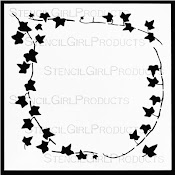StencilGirl Talk: Mary Beth Shaw's VLOG: March 2022
-
StencilGirl Talk: Mary Beth Shaw's VLOG: March 2022: Join Mary Beth in
Amsterdam and Paris! Click here for more information and registration!
Friday, July 31, 2020
Monday, July 27, 2020
Friday, July 24, 2020
Tuesday, July 21, 2020
Saturday, July 18, 2020
Working in a Series with Brand-New Mask LOOKING UP THROUGH TREES SMALL (6" x 6") -- s793
Doubling back to my own post of July 9, the day my newest StencilGirl mask was released, I must once more give credit where it's due.
Some time ago, StencilGirl's Carol Baxter put the bug in my ear to create a 9" x 12" mask, Looking Up Through Trees Large.
 |
| 9" x 12" Looking Up Through Trees Large |
More recently, Carol put a bug in my other ear -- the idea of developing a 6" x 6" Looking Up Through Trees Small to go it alone, or to be used with the original.
 |
| 6" x 6" Looking Up Through Trees Small |
I didn't grasp the genius of Carol's second suggestion till I entered the playground of my imagination with both Trees in hand.
Then two-together ideas started coming so fast that the only way I could keep up would be to put stretch each day into more than 24 hours -- whew! Or maybe the real issue is that I'm slowing down in my old age?
Note: Most often, I'm using both Trees with their outer borders cut off -- not an approach that appeals to everyone, I admit. But I thrive on whacking away at stencils to customize them. Edgar Allan Poe kept re-writing his stories for years, even after they'd been published. So maybe I'm the EAP of the stencil-and-mask world...? I keep "designing" my stencils and masks even after I've designed them!
Any type of sharp, short-bladed scissors works for customizing. My favorite is Joyce Chen scissors -- but they have risen so much price-wise that Fiskars might be a better choice.
Working in a series is a fun way to build up a cache of background papers; but the fun doesn't stop there. Besides blooming into color-coordinated backgrounds for upcoming art projects, a series of similar prints volunteers just as eagerly to become giftwrap, or begs to be cut up for collage or embellishments for party favors or ... pretty much anything else!
Below are four papers printed with 6" x 6" Looking Up Through Trees Small (foreground) and Looking Up Through Trees Large (9" x 12") in the (nearly obscured) background:
... and this brand-new mask itself looks like this:
 |
| 6" x 6" Looking Up Through Trees Small |
That series of four printed papers went to work in several ways.
Above left: one print has been cut into strips. Above right: Some of the strips are cut down even further and are being auditioned as collage pieces, as embellishments atop other papers printed with other stencils and masks.
Above: The audition continues as more pieces are added. Below: In this close-up, the other prints become recognizable. The three-quarters orange and blue paper, as well as the two pieces of red and brown paper along the top, were all printed with the companion mask, 9" x 12" Looking Up Through Trees Large. And the vertical purple paper along the right border was printed with 9" x 12" Clustered Leaves.
Another close-up:
The masks used:
 |
| 9" x 12" Looking Up Through Trees Large |
 |
| 9" x 12" Clustered Leaves |
Yet another piece of paper from this series ....
.... was used to create two parts of the greeting card cover above. The 6" x 6" piece became a background in a size corresponding to the blank greeting card. A purple painted tag was added with a gluestick. My last step was to use a hole punch to cut out a butterfly and add it as the final touch with the gluestick. I use the Pioneer Embellishment Gluestick, which I like for its permanency as well as its ability, as a dry adhesive, to avoid wrinkling papers.
Once I had my first taste of using my butterfly hole punch on these Looking Up Through Trees Small multi-printed papers , I wanted to do more:
What would you do with a series of stencil- or mask-printed papers?
Thank you for taking time to visit here today. A peek ahead:
To scroll thru the pages of my StencilGirl masks and stencils, please start here.
Subscribe to:
Comments (Atom)































































































